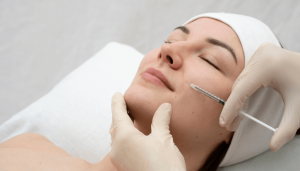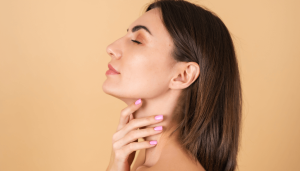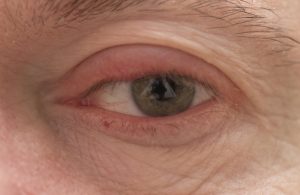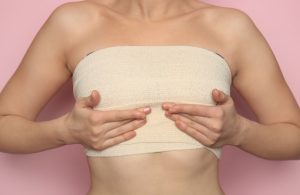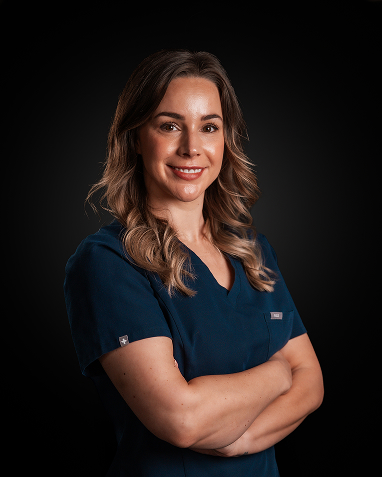How To Get Rid of Blepharitis?
If your eyelids often feel sore, itchy, or crusty, you may have blepharitis. This is a common eye condition that can be bothersome, though it isn’t dangerous. It can make your daily life uncomfortable. Many people wake up with sticky eyelids, red eyes, or a gritty feeling as if sand is in their eyes.
Blepharitis usually doesn’t go away quickly. However, with a consistent routine, you can reduce the symptoms, manage flare-ups & help prevent them from returning.
If you’re wondering how to cure blepharitis fast, this guide walks you through everything.
What Is Blepharitis?
Blepharitis simply means eyelid inflammation. It usually affects the edge of the eyelids where your eyelashes grow. The area becomes irritated when tiny oil glands at the base of your lashes get blocked, causing redness, itching, and sometimes crusting.
It’s a chronic condition for many people, meaning it can come and go over time. But the right care routine can keep it under control so you don’t have to deal with constant irritation.
Medical Treatments for Blepharitis
When home remedies aren’t enough, medical treatments can help control inflammation and prevent flare-ups. There isn’t a complete cure for blepharitis, but with the proper care, you can control symptoms effectively and keep your eyelids comfortable.
In cases of severe or persistent infections, doctors may prescribe antibiotic ointments or drops to reduce inflammation and infection. In certain situations, steroid eye drops may also be used for short periods to calm redness and swelling.
Some patients, especially those who have blepharitis linked to rosacea or skin conditions, benefit from oral antibiotics. These are typically taken for at least four to six weeks, and in chronic cases, they may be continued for several months to keep symptoms under control.
Here are the main medical options your doctor might recommend:
1. Prescription Medications
When bacteria or inflammation are strong contributors, medication can make a real difference.
Options include:
- Antibiotic ointments or drops, such as erythromycin or azithromycin, are used to control bacterial growth.
- Oral antibiotics (like doxycycline or tetracycline) for chronic or rosacea-related blepharitis.
- Steroid drops or ointments to reduce swelling and redness, used under medical supervision.
- Cyclosporine (Restasis) or other anti-inflammatory drops to manage long-term inflammation.
These are usually prescribed for a few weeks and monitored closely by your doctor.
2. Laser and Light-Based Therapies
For some patients, especially those with rosacea-related blepharitis, Intense Pulsed Light (IPL) therapy can help. It targets the blood vessels and inflammation contributing to gland blockage, improving oil flow and reducing symptoms over time.In rare and severe cases, long-term inflammation from blepharitis can cause eyelid deformities or drooping skin. This is where upper blepharoplasty, a surgical eyelid procedure, might help.
How to Get Rid of Blepharitis at Home?
If you’re searching for effective blepharitis home remedies, the key is consistent eyelid hygiene combined with targeted medical treatment when needed. This routine helps reduce redness, swelling, and discomfort while keeping flare-ups under control.
Let’s go step by step.

Ready to achieve your aesthetic goals?
- CQC-Registered Clinic with Nationally Recognised Leadership
- Over a Decade of Surgical & Aesthetic Expertise
- Personalised treatment plans tailored to your needs
1. Keep Your Eyelids Clean
Clean eyelids are the foundation of blepharitis management. The goal is to remove oil, bacteria, and debris without irritating your eyes.
- Wash your hands thoroughly.
- Soak a clean cloth in warm (not hot) water and place it over your closed eyelids for 5-10 minutes.
- Gently massage your eyelids using your fingertips or a cotton swab.
- Clean the base of your eyelashes using a diluted baby shampoo solution or a specially designed lid cleanser.
Do this twice a day when symptoms are bad, then once daily as a long-term routine.
2. Use Warm Compresses
Warm compresses help unclog the oil glands and soften crusts along the lash line.
How to do it:
- Use a clean and soft washcloth soaked in warm water.
- Hold it over your closed eyes for several minutes.
- Gently press and roll the cloth from top to bottom to express oil from the glands.
You can also buy reusable eye masks designed for blepharitis that retain heat longer.
3. Try Eyelid Scrubs or Wipes
Eyelid scrubs or pre-moistened wipes make cleaning easier and more effective, especially if you’re busy or wear makeup. Look for:
- Hypoallergenic or preservative-free wipes
- Formulas with tea tree oil (for Demodex mite control)
- Gentle cleansing agents designed for sensitive eyes
Use these after warm compresses to remove any loosened debris.
4. Manage Dry Eyes
Blepharitis and dry eyes often go hand in hand, each one makes the other worse. Keeping your eyes lubricated reduces irritation and helps your glands work properly.
How to manage it:
- Use preservative-free artificial tears 3-4 times a day.
- Avoid excessive screen time, or remember to blink often while using devices.
- Stay hydrated throughout the day.
- Use a humidifier if your environment is dry.
5. Avoid Eye Makeup (During Flare-ups)
Makeup can block your oil glands and trap bacteria, which makes symptoms worse.
During flare-ups, skip eyeliner, mascara, and eyeshadow until your eyelids heal. When you start using makeup again, follow these hygiene tips:
- Replace mascara and eyeliner every 3 months.
- Avoid sharing makeup.
- Clean your brushes regularly.
- Choose hypoallergenic, non-waterproof products.
6. Use Antibiotic or Steroid Treatments (If Prescribed)
Sometimes home care isn’t enough, especially if your blepharitis is caused by bacteria or severe inflammation. Your doctor might prescribe medication to help clear it up.
Common options include:
- Antibiotic ointments or drops like erythromycin or azithromycin.
- Oral antibiotics such as doxycycline for chronic cases.
- Mild steroid drops or ointments for short-term relief of inflammation.
Never self-medicate. Always follow your doctor’s instructions, since steroids and antibiotics must be used carefully.
7. Treat Underlying Skin Conditions
If you have dandruff, rosacea, or eczema, treating those conditions will help control blepharitis too.
Simple steps that help:
- Use an anti-dandruff shampoo on your scalp and eyebrows a few times a week.
- Follow a treatment plan for rosacea or dermatitis.
- Avoid harsh soaps or facial cleansers that strip natural oils.
Blepharitis is often a symptom of something else; fixing the root problem can make it much easier to manage.
8. Improve Your Diet and Lifestyle
Your diet and habits play a bigger role in eye health than most people think. A few simple changes can reduce inflammation and support healthy oil gland function.
- Eat more omega-3 fatty acids, found in salmon, flaxseeds, walnuts, and fish oil supplements.
- Stay well hydrated throughout the day.
- Reduce alcohol and caffeine, which can dehydrate your eyes.
- Get enough sleep to help your eyes recover overnight.
- Avoid touching or rubbing your eyes unnecessarily.
A balanced lifestyle won’t cure blepharitis instantly, but it strengthens your body’s ability to fight inflammation and maintain eye moisture.
How to Diagnose Blepharitis?
Blepharitis is usually diagnosed through a simple eye examination by an optometrist or ophthalmologist. The goal is to identify what’s causing the inflammation and rule out other eye conditions like conjunctivitis or dry eyes.
Here’s how doctors usually check for it:

Ready to achieve your aesthetic goals?
- CQC-Registered Clinic with Nationally Recognised Leadership
- Over a Decade of Surgical & Aesthetic Expertise
- Personalised treatment plans tailored to your needs
- Medical history: You’ll be asked about your symptoms, lifestyle, and any skin or eye problems such as dandruff, allergies, or rosacea.
- Eyelid examination: The doctor uses a special microscope (slit lamp) to look closely at your eyelids, lashes, and oil glands for redness, flakes, or blocked glands.
- Tear assessment: Simple tests may be done to see how well your eyes produce and retain tears.
- Microscopic tests (if needed): In stubborn cases, a few eyelashes might be examined under a microscope to check for bacteria or tiny Demodex mites.
When to See a Doctor
See an eye doctor if:
- Your symptoms don’t improve after a few weeks of home care.
- You have pain, vision changes, or a stye that won’t heal.
- Your eyelids are swollen or crusty to the point of discomfort.
They may run tests to rule out infections or other eye diseases.
Final Thoughts
Blepharitis may seem simple, but it can become a daily annoyance if left unaddressed. The good news is you can manage it effectively with consistent care.
Start with warm compresses and lid hygiene. Manage dryness, treat any skin conditions, and stay in touch with your eye doctor. If home remedies aren’t effective, medical treatments can help restore comfort and improve your eyelid health.
There’s no instant fix, but with patience and consistency, you can keep your eyelids calm, clean, and clear and your eyes feeling like themselves again.
Frequently Asked Questions
01. How can I get rid of blepharitis quickly?
You can ease blepharitis fast by keeping your eyelids clean every day. Use a warm compress, gently massage your lids, and clean your lash line with diluted baby shampoo or eyelid wipes to remove oil and flakes.
02. Does drinking more water help blepharitis?
Yes. Staying well-hydrated can help keep your eyes and skin moist, reducing dryness and irritation that make blepharitis worse.
03. How long does blepharitis last?
Blepharitis often doesn’t go away completely. It can last for weeks or months and may come back, so regular eyelid cleaning is important to keep it under control.
04. Can stress cause blepharitis?
Yes. Stress can trigger or worsen blepharitis by affecting your skin and oil glands. It may also aggravate conditions like rosacea or dandruff that contribute to eyelid inflammation.
05. What are the first signs of blepharitis?
The first signs usually include red, swollen eyelids, itching, a burning or gritty feeling in the eyes, and tiny flakes or crusts around the lashes.

